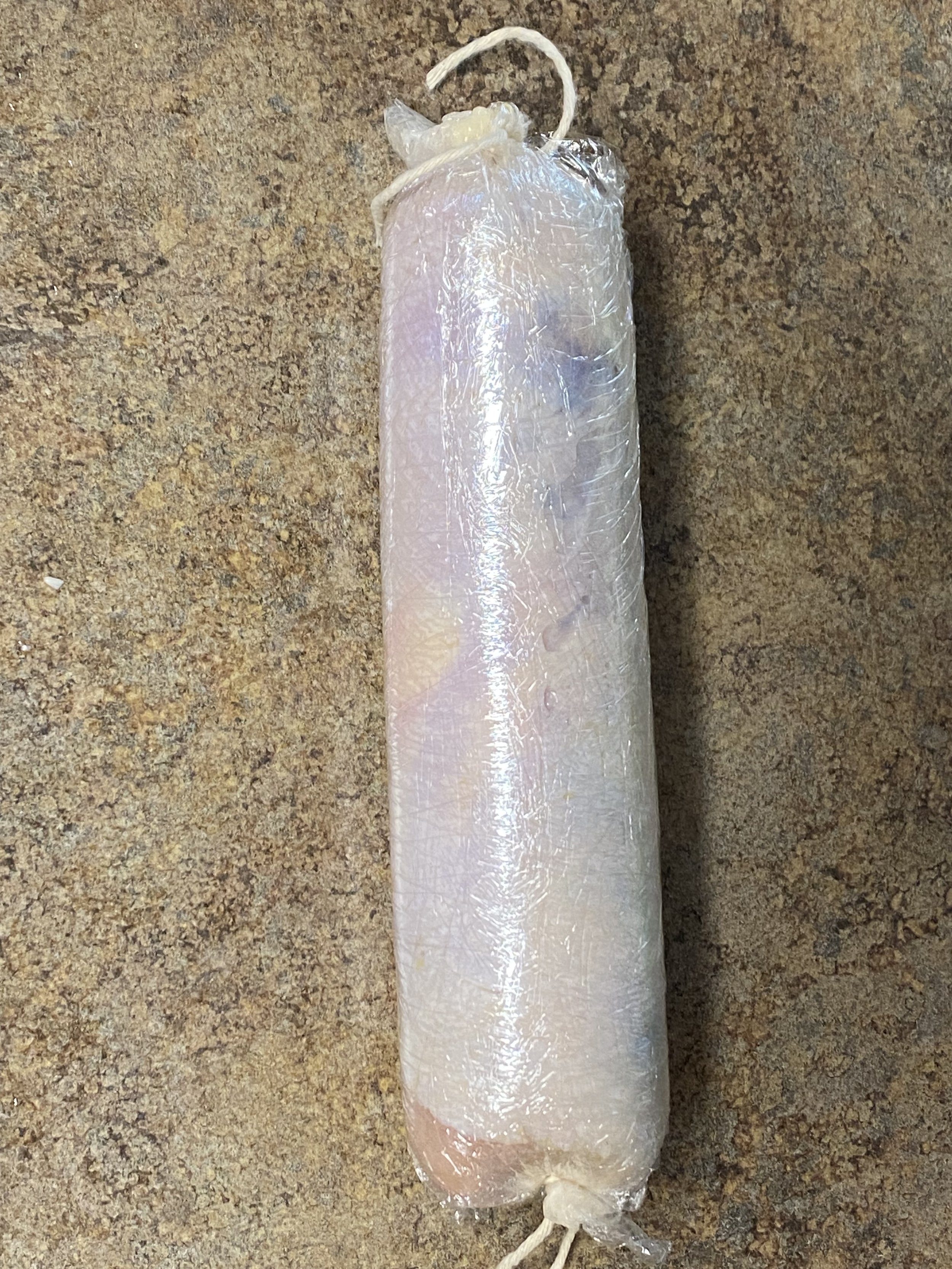Galantines
Winter time is perfect for practicing (and eating) terrines, pates, galantines, etc… I remember serving several CMC judges delicious slices of duck galantine during the Charcuterie segment of the Certified Master Chef exam. I decided to prepare a contemporary style of galantine that day where I pounded seasoned duck breasts into a flat sheet, then wrapped the breast' ‘sheet’ around the duck forcemeat and then wrapped this with duck skin. Oftentimes chefs assemble the galantine with whole breasts. (as I did with the chicken galantine in these photos)
To prepare a galantine, fabricate one whole duck and separate the bones, skin, breasts, legs and dark meat into separate containers. It’s very important to respect the food and utilize every part of the duck-and remember to keep everything very, very, very cold!
I chill the duck skin to harden the fat and then carefully shave the excess fat without cutting into the skin, creating a perfectly even wrap for the forcemeat. I usually lay the duck skin on a half sheet pan with plastic wrap and periodically freeze- shave; freeze-shave until I get the skin perfectly free of fat.
Season the duck breasts and carefully flatten two duck breasts with a mallet into one large, thin sheet to fit perfectly over the skin of the whole duck. I like to flatten with plastic wrap above and beneath the duck meat to protect it. This takes patience and time to make it perfect.
Next clean all of the excess meat from the bones, season with cognac, orange zest, pate spice, salt and glace de volaille for a few hours to develop flavor and finally grind the forcemeat. I like adding a cooled panada of diced, white bread and sweated shallots simmered in cream for texture and fat. I sometimes use pork fatback in the forcemeat as well. Always poach a taster and evaluate before assembly.
It’s important to use all of the duck so I generally poach the liver, stomach and heart until tender and dice for garnish. Since I wanted a more classic galantine during the CMC exam, I garnished with truffle macerated in cognac, blanched, peeled pistachios, diced, duck tenderloins and poached, diced smoked tongue. I remember making a delicious duck stock to poach my galantine in. During that day of the exam I made two galantines, one wrapped in cheesecloth and one wrapped in plastic. The galantine wrapped in plastic was far more delicious… the cheesecloth wrapped version lost some of the flavor into the poaching stock. Rookie mistake on my part!
The chicken galantine I made this weekend is very similar but with sautéed, wild mushrooms and pistachios-so fun to make and enjoy on a cold, winter afternoon.
Please reach out if you have any questions… I’m a huge fan or making forcemeats!
Assembly of a chicken galantine
The chicken skin has much of the fat removed and is spread evenly on a sheet of plastic or cheesecloth; in this photo the breasts are lightly pounded to overlap evenly but still resemble a full chicken breast-seasoned with cognac, pate spice, salt and pepper and then placed in the center of the chicken skin. I sometimes pound the breast flat (1/8th of an inch) and lay the breast meat evenly onto the skin as I did for the duck galantine. In this style the skin should be about 2 inches wider on each side to make up for the forcemeat.
Some Garde Manger Chefs actually don’t cut the chicken breast from the skin; it’s left on the skin.
Next the forcemeat is evenly piped on top with a pastry bag. Be careful not to put too much forcemeat or you won’t be able to wrap the skin around the final galantine.stand out. I like to lay out a short piece of butcher’s twine to measure the width of the chicken skin and use the string as a ‘ruler’ to know how much filling I can pipe into my galantine.
Sometimes I’ll lay thin slices of prosciutto onto the skin and then put the breasts and forcemeat over the prosciutto. That’s visually appealing and delicious!
Note-always poach off a sample of the forcemeat and evaluate for flavor and texture before assembling!
Wrapping the galantine
To wrap, just fold the chicken skin from the two sides over the middle, overlapping by at least an inch (for shrinkage). Then wrap the plastic around the galantine and tie the ends.
It’s great to have a helper to tie the strings on each end, make sure the galantine is wrapped very tightly in cheesecloth or plastic. I twist the ends about 10 times until I get a small bubble to anchor the string. It holds much better with the bubble anchor. You can see these in the photo.
I often wrap the galantine and freeze it for about an hour, then unwrap and rewrap more tightly when the galantine is very cold.
I wrap my galantine in a clean, wet side towel to weigh the galantine down under the water but protect it from touching the bottom of my poaching vessel. I generally use an oval, fish poaching pan since it fits perfectly in this long pot.
Cooking, cooling and Slicing the galantine.
Poach gently, since this is a delicate forcemeat, in heated water which is 250° F on top of the stove to reach an internal temp of 160° F. It will carry up to 165°F as I let it cool in the warm water. It’s important to keep the galantine under the water and the towel helps to weigh it down.
I find the flavor and texture improves after a day in the refrigerator so I like to make extra forcemeat and poach these as ‘Chef snacks’.
I suggest slicing with a very sharp, beveled knife for a smooth cut and I leave the plastic on when I slice to protect the skin (but be very careful to peel the plastic off and discard!) Enjoy and please reach out with questions or comments.





